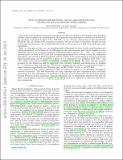| dc.contributor.author | Benneke, Bjoern | |
| dc.contributor.author | Seager, Sara | |
| dc.date.accessioned | 2014-03-27T15:44:05Z | |
| dc.date.available | 2014-03-27T15:44:05Z | |
| dc.date.issued | 2013-12 | |
| dc.date.submitted | 2012-07 | |
| dc.identifier.issn | 0004-637X | |
| dc.identifier.issn | 1538-4357 | |
| dc.identifier.uri | http://hdl.handle.net/1721.1/85925 | |
| dc.description.abstract | One of the most profound questions about the newly discovered class of low-density super-Earths is whether these exoplanets are predominately H2-dominated mini-Neptunes or volatile-rich worlds with gas envelopes dominated by H2O, CO2, CO, CH4, or N2. Transit observations of the super-Earth GJ 1214b rule out cloud-free H2-dominated scenarios, but are not able to determine whether the lack of deep spectral features is due to high-altitude clouds or the presence of a high mean molecular mass atmosphere. Here, we demonstrate that one can unambiguously distinguish between cloudy mini-Neptunes and volatile-dominated worlds based on wing steepness and relative depths of absorption features in moderate-resolution near-infrared transmission spectra (R ~ 100). In a numerical retrieval study, we show for GJ 1214b that an unambiguous distinction between a cloudy H2-dominated atmosphere and cloud-free H2O atmosphere will be possible if the uncertainties in the spectral transit depth measurements can be reduced by a factor of ~3 compared to the published Hubble Space Telescope Wide-Field Camera 3 and Very Large Telescope transit observations by Berta et al. and Bean et al. We argue that the required precision for the distinction may be achievable with currently available instrumentation by stacking 10-15 repeated transit observations. We provide a scaling law that scales our quantitative results to other transiting super-Earths and Neptunes such as HD 97658b, 55 Cnc e, GJ 3470b and GJ 436b. The analysis in this work is performed using an improved version of our Bayesian atmospheric retrieval framework. The new framework not only constrains the gas composition and cloud/haze parameters, but also determines our confidence in having detected molecules and cloud/haze species through Bayesian model comparison. Using the Bayesian tool, we demonstrate quantitatively that the subtle transit depth variation in the Berta et al. data is not sufficient to claim the detection of water absorption. | en_US |
| dc.language.iso | en_US | |
| dc.publisher | IOP Publishing | en_US |
| dc.relation.isversionof | http://dx.doi.org/10.1088/0004-637X/778/2/153 | en_US |
| dc.rights | Creative Commons Attribution-Noncommercial-Share Alike | en_US |
| dc.rights.uri | http://creativecommons.org/licenses/by-nc-sa/4.0/ | en_US |
| dc.source | arXiv | en_US |
| dc.title | HOW TO DISTINGUISH BETWEEN CLOUDY MINI-NEPTUNES AND WATER/VOLATILE-DOMINATED SUPER-EARTHS | en_US |
| dc.type | Article | en_US |
| dc.identifier.citation | Benneke, Björn, and Sara Seager. “HOW TO DISTINGUISH BETWEEN CLOUDY MINI-NEPTUNES AND WATER/VOLATILE-DOMINATED SUPER-EARTHS.” The Astrophysical Journal 778, no. 2 (December 1, 2013): 153. | en_US |
| dc.contributor.department | Massachusetts Institute of Technology. Department of Earth, Atmospheric, and Planetary Sciences | en_US |
| dc.contributor.department | Massachusetts Institute of Technology. Department of Physics | en_US |
| dc.contributor.mitauthor | Benneke, Bjoern | en_US |
| dc.contributor.mitauthor | Seager, Sara | en_US |
| dc.relation.journal | The Astrophysical Journal | en_US |
| dc.eprint.version | Original manuscript | en_US |
| dc.type.uri | http://purl.org/eprint/type/JournalArticle | en_US |
| eprint.status | http://purl.org/eprint/status/NonPeerReviewed | en_US |
| dspace.orderedauthors | Benneke, Björn; Seager, Sara | en_US |
| dc.identifier.orcid | https://orcid.org/0000-0002-6892-6948 | |
| mit.license | OPEN_ACCESS_POLICY | en_US |
| mit.metadata.status | Complete | |
